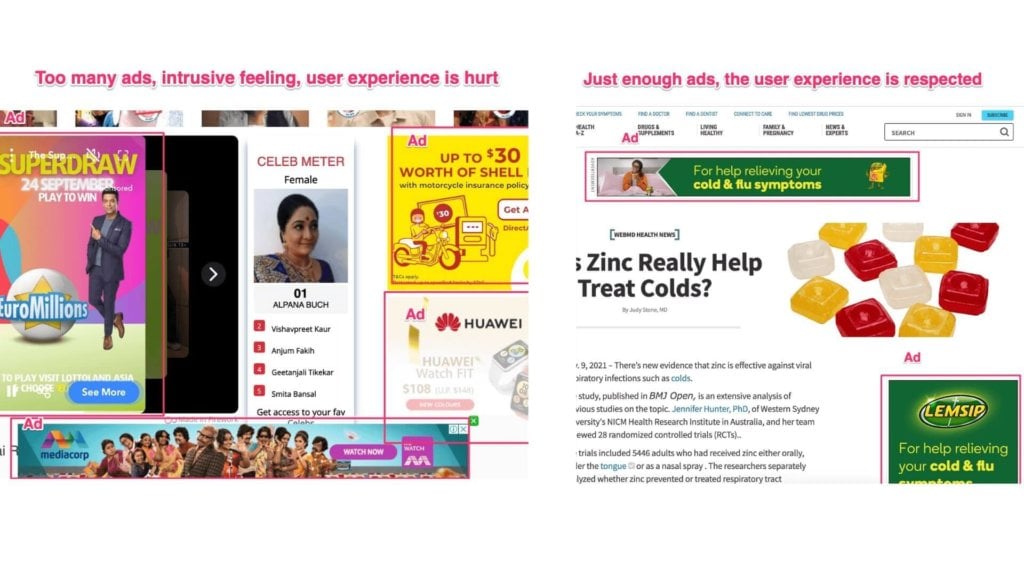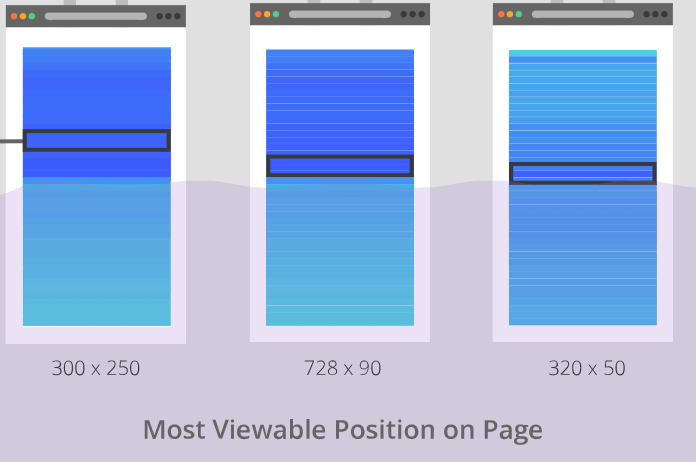Ad Viewability | What is It and How to Improve It?
Ad viewability is one of the most frequently discussed topics in the advertising industry. It’s sometimes referred to as the main currency of display and video advertising.
So, why is ad viewability so important?
An ad served doesn’t necessarily equal that the user had seen it. Advertisers tend to target websites with high ad viewability because it generates a better performance and ROI (return on investment) on their campaigns.
Both publishers and advertisers are striving to increase their ad viewability rate. In this article, you will learn what ad viewability is, why it is important, and tips to improve it.
What is Ad Viewability?
Ad viewability is a metric used in digital advertising to measure how visible the ads are to users on the publisher’s website.
According to the Interactive Advertising Bureau’s (IAB) and Media Rating Council (MRC) standard, for an ad to count as viewed, 50% of it must be visible to a user for at least 1 second. For video ads, 50% of the ad must be visible for at least 2 seconds. Google refers to viewable impressions as ‘Active View‘.
However, different SSPs may use a different viewability measurements. For example, when it comes to large-size creatives (display ads sized at 242,500 pixels or greater), Xandr and OpenX count the ad as viewed when 30% of the creative is visible for 1 second.
What’s The Ideal Ad Viewability Score?
According to the data from leading SSPs like Xandr, OpenX, and Rubicon, the ideal ad viewability score should be above 70%.
50%-70% is acceptable, but for optimal results, you need to try and reach above 70%.
Below 50% is too low, so you must focus on your ad viewability.
The higher the ad viewability rate, the better the performance and the demand for your inventory will be.
How to Measure Ad Viewability – The Formula
To measure ad viewability, you must find the total viewable ad impressions served and divide it by the total. In other words, ad viewability rate is the percentage of viewable ads out of the total number of served ads.

Viewable impressions served–the number of times your ad impressions were considered viewable (you can see this metric in your Google Ad Manager or any other ad server).
Viewable impressions allow publishers and advertisers to understand if the ad was displayed in a viewable position.
Why is Ad Viewability Important?
SSPs have pointed out that reaching above 70% ad viewability is important. According to a report, global desktop ad viewability reached 71.9% in 2020 and 67.6% for mobile.
If users don’t view more than half of the served ads, ad campaigns become ineffective, and the price is much less than for a viewable ad. Other metrics, such as viewable time and user engagement, clarify the ad inventory’s value more. As a result, publishers have a clear picture of the best-performing inventory and can optimize their sites accordingly.
Ad viewability is one of the most crucial metrics for advertisers and is equally important for brand awareness and performance campaigns. A study by Google concluded that viewable display ads across the Google Display Network had a 4X lift in conversions than display ads that don’t meet the ad viewability standard.
The programmatic industry currently focuses more on checking viewable impressions than served impressions.
Setupad’s dashboard lets you check ad viewability for the whole ad inventory for a selected time period.

Additionally, our dashboard now includes the ad viewability rate for each ad unit and the total ad viewability for domain-level for selected time periods.

What can cause a low ad viewability score?
- Page length and quality of the content–according to Google, shorter content has higher viewability. Setting pages with a single fold allows users to get through content more easily.
- Slow load of ads–if your ads don’t load fast enough, users might scroll past them before they load, causing a drop in viewability.
- Ad position–ads placed below the fold have a lower viewability rate.
- Ad units–some ad units influence the viewability results, regardless of how fast they load or what ad format is used. For example, the top leaderboard would rarely have viewability above 50%.
- User behavior on a website–if users don’t interact with your page long enough, it can create low engagement meaning that ads can be requested but aren’t served.
- Internet speed–if the user’s connection is slow, ads might not load. Therefore, you must have a speedy and responsive website or app for ads to load faster and achieve higher ad viewability.
6 Tips to Improve Ad Viewability
Follow these tips below to improve your ad viewability rate:
1. Improve the page speed of your website
A slow-loading website is the biggest offender of ad viewability. Page speed directly affects ad revenue, so consider making page speed your top priority.
To improve page speed on your site, we recommend:
- Using responsive layouts
- Reducing redirects
- Optimizing images to improve server response time
- Using asynchronous ad tags
Setupad Expert Opinion:
Povilas Goberis, COO at Setupad: “There is a trend that we’re seeing where high viewability is correlated with the website’s overall performance. According to our publisher data, if the website is well-optimized, it has a good ad viewability rate in all placements. In other words, it’s not just sticky and interstitials that have high viewability rate (which is the case for most websites), but also all other placements.”
2. Improve ad load speed
One of the most critical factors impacting ad viewability is user behavior combined with the ad load speed.
This means that even if your website is fast but ads take too long to load, there might be a negative impact on your ad viewability.
To improve your ad load speed:
- Implement lazy loading for below-the-fold ads. The concept of lazy loading is simple–an ad request is triggered right when the user is most likely to see it. But remember, there is no point in implementing lazy-loading for banners that are visible above the fold because you want them to load as fast as possible.

- Minimize passbacks. This will reduce the number of ad calls made from one server to another. Fewer ad calls will reduce page latency and improve ad viewability. Moreover, this can help your video inventory, as videos load faster, and users are more likely to stick around and watch them.
3. Choose the best-performing ad sizes
The most viewable ad sizes are the vertical sizes units, for example, 160×600. Vertical ad sizes stay in view longer than horizontal. Not surprisingly, sidebars have the highest viewability rate in the industry.
Setupad also offers publishers sticky banners, which stick to the viewport and stay in view for the whole visit duration.

Typically, reaching optimal viewability might not be easy if the banner is large. That’s because the user needs to scroll more so that 50% of the banner is in view. Therefore, some SSPs even have different measurement criteria for larger-sized banners.
It’s also important to use high-performing mobile ad sizes, such as medium rectangle (300×250) and large mobile banner (320×100) to get the best results.
4. Implement ad refresh
Ad refresh allows reloading ads if they are in view for some time. This will guarantee that the new ad will be visible immediately after rendering it. Also, this will increase your ad placement’s viewability score in your ad server and get more ad impressions, thus increasing ad revenue.
But don’t get carried away and let the ad show for at least 20 seconds so the user can actually notice it and hopefully click on it. A high ad refresh rate will lower your CTR score. At Setupad, we utilize a smart ad refresh mechanism that considers user behavior and refreshes the ads only when it benefits the publisher.
How Setupad improved ad viewability and generated 65% more revenue from our smart ad refresh!
5. Get more familiar with your audience’s behavior
When you understand which pages users spend most of the time and engage with the content, you can decide how many ads you should serve. Having too many ads can harm the user experience, as too many multiple ad requests to your ad server could cause page latency. Monetization companies, like Setupad, can help you and suggest the optimal number of ads on your page.

Remember, sometimes less is more. To reach higher overall ad viewability on the domain level, consider removing low-performing ad placements, for example, below-the-fold (BTF) placements.. Advertisers are looking at the inventory as a whole, so by removing low-performing placements, you can increase the total ad viewability for your inventory.
Related Article: How Many Ads Should I Put on My Website?
6. Choose the best-performing ad placements
Ad placements are one of the most important factors influencing ad viewability rate. According to a study by Google, above-the-fold (ATF) video ads, on average, have a 73% viewability score, compared to 45% for below-the-fold (BTF) ads.
Based on these figures, your aim should be to keep your site’s viewability score either the same as the industry average or slightly higher.
The most viewable ad placement is an ad right above the fold, not at the top of the page.

However, that doesn’t mean that placements below the fold aren’t viewable at all. If there is content below the fold that holds a user’s attention, then that area of the page might have the highest viewability.
Nevertheless, it’s advisable to stick to the most popular ad placements and ad sizes to reach maximum viewability.
When deciding on ad placements, it’s also important to consider user experience. Google’s John Mueller pointed out that there has to be some content above the fold, meaning that a part of the publisher’s page should be visible when a user visits the site.
Place ads in line with the site’s main content or content-rich areas. Avoid placing ads in areas with little or no content.
Before making any ad placement decisions, you can review where your site’s page fold is most often located. You can do it by using heatmap tools or the Google Analytics screen resolution report. Alternatively, you can delegate this task to your monetization partner.
Final Thoughts
Publishers should continuously improve the loading speed of their webpage and user experience. High-viewability inventory is becoming more relevant, and advertisers are shifting their attention to metrics like vCPM (viewable CPM) instead of CPM.
The content of the website and the ads should both load at the same time but asynchronously. This will help to improve your ad inventory’s quality and increase ad revenue.
Viewability helps publishers ensure they can use their inventory fully by serving ads. By focusing on page design, website, ad speed, and creating engaging content, publishers can reach higher viewability and entirely use their inventory by serving ads.


